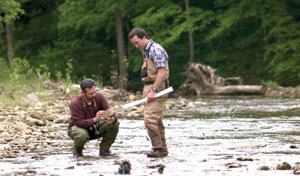![]() Current Issue
Current Issue
(Fall 2005)
A Creek Reborn
The human alteration of Wilson Creek in rural Bullitt County, Ky., began in the 1700s. Now a team of U of L scientists and others have the rare opportunity to radically restore the stream to its original state.

Engineers Art Parola (left) and Bill Vesely examine the progress of Wilson Creek's restoration.
When Michelangelo carved a statue, he said he was merely releasing the form that God had already placed inside the slab of stone.
Now U of L engineers and colleagues are similarly releasing a stream in the Bernheim Arboretum and Research Forest that had been filled in, plowed over and moved by farmers long ago.
The restoration of Wilson Creek is an unprecedented opportunity for engineers, biologists, arborists and landowners to see what happens when a stream is rebuilt almost from scratch.
The demonstration project should provide how-to information to landowners and others across the country on effective ways to restore stream beds altered by human activities. Such restorations could reduce soil erosion and downstream pollution as well as increase biological diversity.
Bernheim Forest is managing the project with technical assistance from U of L, the University of Kentucky School of Forestry and others. The project is funded with $500,000 mostly from the U.S. Environmental Protection Agency (EPA).
Wilson Creek is just one example of how streams across America have been altered from the very beginning of the nation’s history.
“Virtually every flat piece of land has been farmed, and farmers can’t tolerate streams interacting with the plain, so they straighten and move the streams so that the water flows quickly from the property,” says Art Parola, professor of civil and environmental engineering in U of L’s Speed School of Engineering and lead designer of the Wilson Creek restoration.
The same thing happened to Wilson Creek.
Between 1770 and 1790 settlers surveyed the Bernheim Forest area for agricultural and other uses. For more than a century the land in and around Wilson Creek was intensively logged, cleared, farmed and mined for salt and iron ore. As a result, the meandering stream was straightened and set along a hillside to increase the amount of farmable land in the valley.
When the park’s administrators decided five years ago to restore the creek, they called Parola for advice.
“When we first walked the creek,” Parola explains, “it was obvious to me that it had been straightened. I said it would be better to first move the creek to the middle of the valley where it belongs rather than revegetate it in the position it was in.”
Straightened or “channelized” streams tend to erode quickly because there are no bends to slow them down or places for the water to overflow when it rises. The resulting rushing water eroded Wilson Creek to the bedrock in spots, reducing algae and other life forms necessary for healthy ecosystems.
Parola has spent years researching waterway-related engineering problems. He and colleagues studied the topography and ecosystems of Wilson Creek and other streams for five years before the first rock was moved from the site.
The restoration team, including graduate students Bill Vesely and Mike Croasdaile, surveyed the area and dug test pits to find the old stream bottom. Vesely was construction manager as well as co-principal designer of the site with Parola. CEE professor Donald J. Hagerty examined soils at the site while department chair Mark French looked at the area’s hydrology.
“The complexity,” Parola says, “is in the details, such as how sharp a bend is and how deep the channel should be.”
Bulldozers and crews moved in last summer and scraped the valley floor bare before carving out the new stream channel. The restored creek merges at points with its previous incarnation, since those areas were part of its original course. Water was diverted into the new stream, and the unused portions of the old stream are being turned into wildlife-friendly wetlands.
The restorers say that for awhile the results will look like a construction site. But that will change with time as vegetation and wildlife return and slight modifications are made to the stream.
The 4,000-foot section of restored creek with its twists is about 15 to 20 percent longer than the old one, Parola says.
The researchers say the snaking pattern is essential to a healthy stream’s ecosystem because it lets the stream slow down and harbor life. It also permits occasional overflows that deposit nutrients into the surrounding soil.
Parola says that the stream’s design was key to ensuring it would function properly and allow for a diverse habitat to develop.
“Interaction with the floodplain is key,” Parola says. “Streams undergo constant change—they change course, erode their banks and overflow and deposit sediment onto the floodplain.”
The creek’s revegetation will take years as newly planted trees such as sycamore, sugar maples and poplars as well as grasses and shrubs regrow. UK assistant forestry professor Chris Barton and contractor Adam Dattilo are overseeing the replanting.
“This is a long-running work-in-progress,” Parola adds. “We will monitor the physical conditions and entire environment of the valley, including upstream and downstream. We’ll do additional physical modifications this spring and into summer.
“It will be a four- to five-year project to see how the channel physically changes.”